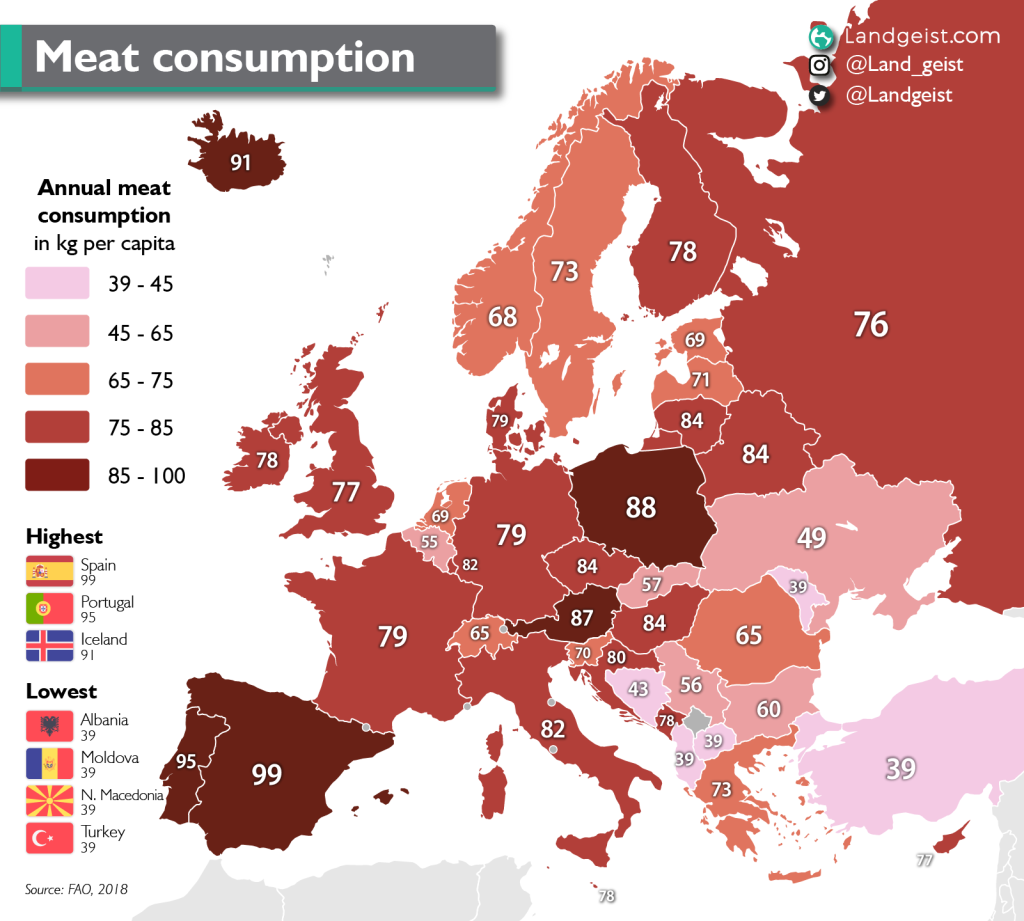Meat Consumption in Europe Map


Marcus Rodriguez
Historical Geography Expert
Marcus Rodriguez specializes in historical cartography and geographic data analysis. With a background in both history and geography, he brings unique...
Geographic Analysis
What This Map Shows
The "Meat Consumption in Europe Map" provides a comprehensive overview of the varying levels of meat consumption across European countries. This visualization highlights not only the total meat intake per capita but also distinguishes between different types of meat, such as beef, pork, poultry, and lamb. By examining this map, we can gain insights into dietary preferences, agricultural practices, and cultural influences that shape the meat consumption landscape in Europe.
Deep Dive into Meat Consumption in Europe
Meat consumption is a significant aspect of dietary habits, and Europe presents a fascinating case study due to its diverse culinary traditions and economic factors. In recent years, the average meat consumption in Europe has seen fluctuations, influenced by health trends, environmental concerns, and animal welfare issues. Interestingly, the European Union's average meat consumption per person hovers around 80 kilograms annually, but this figure masks considerable variation between countries.
For instance, countries like Luxembourg and Austria lead the pack with average consumption rates exceeding 100 kilograms per capita. Luxembourg's high meat consumption can be attributed to its affluent lifestyle and diverse food culture, where meat plays a central role in traditional dishes. On the other hand, countries like Albania and Romania exhibit lower consumption rates, often below 50 kilograms per capita. This discrepancy can be linked to economic constraints and a greater emphasis on plant-based diets in certain regions.
When we delve deeper into the types of meat consumed, poultry emerges as the most popular choice across Europe, with a notable rise in demand over the past decade. This shift can be attributed to the perception of poultry as a healthier and more sustainable alternative to red meat. Interestingly, countries like Spain and France have a longstanding tradition of consuming pork, reflected in their culinary staples such as jamón ibérico and cochon de lait. In contrast, the consumption of beef has seen a decline, partly due to health concerns and the growing popularity of vegetarian diets.
As the plant-based movement gains momentum, many European countries are witnessing a transition toward reduced meat consumption. Initiatives promoting plant-based diets are becoming increasingly popular, with countries like Sweden and Germany leading the charge. Moreover, the European Union has introduced policies aimed at reducing greenhouse gas emissions from livestock farming, which could further influence meat consumption patterns in the coming years.
Regional Analysis
Examining the map closely reveals distinct regional patterns in meat consumption. In Northern Europe, for instance, Finland and Sweden report higher levels of poultry consumption, reflecting a trend towards lighter meats. However, moving southward to Mediterranean countries, such as Italy and Greece, we see a preference for red meats, particularly in traditional dishes.
Interestingly, the Balkans showcase a unique blend of meat preferences, with a high consumption of both pork and lamb, reflecting cultural influences from both Eastern and Western culinary practices. In contrast, Western Europe, including countries like the Netherlands and Belgium, tends to have a more balanced approach, with significant consumption of all types of meat but a marked increase in poultry.
Moreover, the disparities between urban and rural areas also play a crucial role in consumption patterns. Urban centers typically exhibit lower meat consumption due to the rising trend of vegetarianism and veganism, particularly among younger populations. Conversely, rural areas maintain higher levels of traditional meat consumption, closely tied to local agricultural practices and cuisine.
Significance and Impact
Understanding meat consumption patterns in Europe holds significant implications for health, the environment, and agricultural policies. As consumers become increasingly aware of the health risks associated with high meat consumption, such as cardiovascular diseases and obesity, many are seeking alternatives. This shift towards plant-based diets not only benefits individual health but also contributes to reducing the ecological footprint of food production.
Additionally, the livestock industry is a significant contributor to greenhouse gas emissions, and with Europe striving to meet climate goals, changes in meat consumption could lead to substantial environmental benefits. Looking ahead, projections suggest that if current trends continue, we may see a further reduction in overall meat consumption across Europe, particularly in younger generations.
Ultimately, the "Meat Consumption in Europe Map" serves as a crucial tool for understanding the complex interplay of cultural, economic, and environmental factors that shape dietary habits. By analyzing these patterns, stakeholders can better address the challenges related to food production, sustainability, and public health in the future.
Visualization Details
- Published
- October 14, 2025
- Views
- 30
Comments
Loading comments...